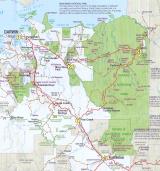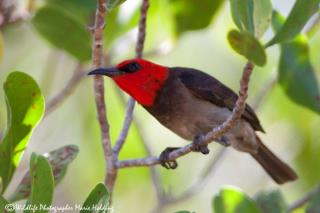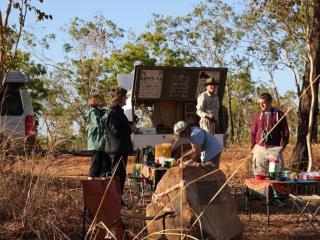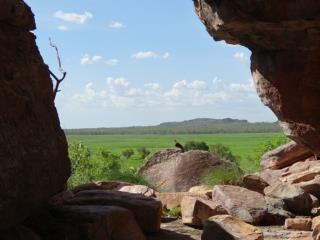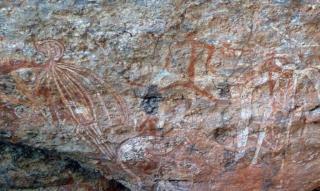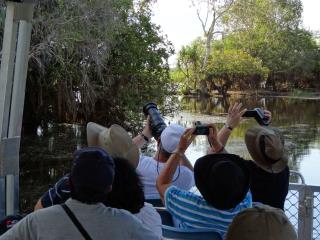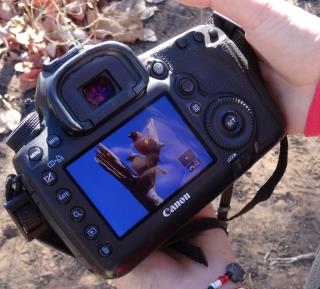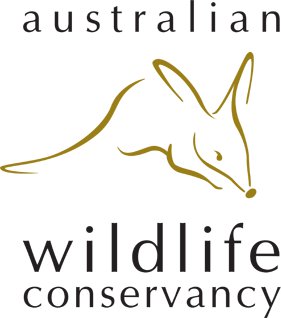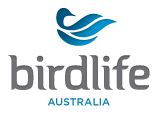Top End Wildlife Photography
Seven day's of wildlife watching around Darwin, Kakadu, Katherine and Litchfield

-
Seven day, six night tour starting with prime birding locations around Darwin's mangroves, monsoon forests and parklands, then to the famous Fogg Dam Conservation Reserve. We explore Mary River's wetlands and surrounding savannah woodlands and then through to the dramatic sandstone escarpments and wetlands of Australia's largest National Park, Kakadu. We go to Katherine Gorge in Nitmiluk National Park, bird areas around Pine Creek before returning to Darwin via the scenic Litchfield National Park. Total distance covered - 1400 kilometres. See map.Top End Photography Tour route map. The numbers are showing where each night is spent. (photo copyright Tourism NT)
- Key species - Rainbow Pitta, Green-backed Gerygone, Broad-billed Flycatcher, Crimson Finch, Long-tailed Finch, Gouldian Finch, Hooded Parrot, Northern Rosella, Red-winged Parrot, Cockatiel, Red-tailed Black Cockatoo, Buff-sided Robin, Partridge Pigeon, Black-tailed Treecreeper and Sandstone Shrike-thrush. Red Goshawk, Black-breasted Buzzard. Kakadu escarpment endemics such as Chestnut-quilled Rock-pigeon, White-lined Honeyeater and Banded Fruit-dove.
- Will this tour suit me? All accommodation is in comfortable air-conditioned rooms with ensuites. We start before dawn and stop for a bush breakfast at beautiful locations surrounded by birdlife at its busiest. Lunch is enjoyed out in the field and dinners are ala carte menus at resorts or restaurants. This itinerary is ideal for photography as it allows plenty of time in each location. For this tour we use our Land Rover Discovery and only four guests. This allows plenty of room for camera gear in the vehicle and at any time three guests have a wind down window to utelize opportunities to shoot from the car, which is effectively a great hide!
- Cost - $3745 per person twin share
- 2018 dates - TBA
"Ellen and I did enjoy our tour with you very much. I think we saw more birds, photographed them in better light, learned more about them and other things about Australia than all our other tours combined. Thanks again for the ‘expedition’ summary. That will be a good reference in future years of the trip. And if it should come up, we’ll send our adventuresome birding friends in your direction."
Frank and Ellen, USA
August 2012
Itinerary
DAY 1 - DARWIN to MARY RIVER
Pick up from Darwin accommodation - 7.00am
We start with visits to habitats rich in bird-life in and around Darwin.
Within minutes of leaving the city, we visit monsoon forest in search of the endemic Rainbow Pitta, Rose-crowned Fruit-Dove, Varied Triller and Brown Whistler; then we go to a nearby rocky coastline in search of shorebirds, Sacred Kingfisher and Brahminy Kite.
We take the boardwalk that goes right through the mangroves to the mudflats, with a pleasant landing that allows us to sit, listen and observe while various waders, Red-headed Honeyeaters, Broad-billed Flycatchers, Collared Kingfishers, and others come into sight. After visiting some savannah woodland habitat for Forest Kingfisher, Double-barred and Long-tailed Finch, Red-tailed Black Cockatoo, Spangled Drongo and others, we head out to the wetlands of Fogg Dam Conservation Reserve.
The 60 kilometre drive out to Fogg Dam gives us the opportunity to spot various raptors, kingfishers and the Blue-winged Kookaburra, as well as see a blend of savannah woodland and paperbark forest habitats. At Fogg Dam, the Pandanus lookout is a great place to eat our picnic lunch overlooking the floodplain. The spotting scope is set up and we pick out Magpie Geese, Intermediate Egret, Little Egret, Great Egret, Cattle Egret, Pied Heron, Royal Spoonbill, Little Black Cormorant, White-browed Crake, Black-necked Stork and sometimes Brolga from here. Whistling Kites and often a White-bellied Sea-eagle soar overhead. Crimson Finch, Rufous-banded Honeyeater, Lemon-bellied Flyrobin, Rose-crowned Fruit-Dove, Forest Kingfisher, Sacred Kingfisher and Paperbark Flycatcher are some of the species that occupy the bush on the edge of the floodplain and are often seen in the carpark area. Estuarine Crocodiles, Gilberts Dragon’s, Yellow-spotted Monitors, Northern Long-necked Turtles and Common Tree Snakes may be seen here.
Then we explore the Waterlilies walk which takes us along the fringe of wetland, through paperbark forest. We often see Rainbow Pitta, Brown Whistler, Arafura Fantail and Shining Flycatcher.
We stop at Adelaide River Bridge and search for Mangrove Golden Whistler then continue on to the Mary River Wilderness Retreat and compare notes on sightings for the day. Listen for Bush Stone-curlew, Tawny Frogmouth and Barking Owl at night.
Dinner and accommodation is in a comfortable, air-conditioned Bush Bungalow at Mary River Wilderness Retreat.
DAY 2 - EXPLORE MARY RIVER
Bush breakfast on the Marrakai track.
We spend the morning exploring savannah woodland country down the Marrakai track. Our number one target is the rare and spectacularly beautiful Gouldian Finch. This track is amazingly productive for bird sightings all along the track. Species we may see in addition to Gouldian Finches are Masked, Long-tailed, Double-barred and Crimson Finches, Black-tailed Treecreeper, Varied Sitella, Diamond Dove, Channel-billed, Brush, Pallid and Little Bronze Cuckoos, Red-backed Fairy-wren, Northern Rosella, Varied Lorikeet, many raptor species including Black Falcon and Black-breasted Buzzard, as well as many of the more common species. We have morning tea on the banks of the Margaret River where we usually get sightings of Buff-sided Robin, Shining and Paperbark Flycatchers and Arafura Fantail. Mammal species in the area are Agile Wallabies, Antilopine Wallaroos and Dingoes.
Next we take the turn off to Bird Billabong in Mary River National Park, and do a 4 kilometre (return) walk through bushland and floodplain to the Bird Billabong hide, with views of Magpie Geese, Intermediate Egret, Little Egret, Great Egret, Cattle Egret, Pied Heron, White-necked Heron, Royal Spoonbill, Little Black Cormorant, Black-fronted Dotterel, Black-necked Stork and often some Estuarine Crocodiles and many bush birds, including Rufous Whistler, Red-backed Fairy-wren, Gouldian Finch, Masked Finch, Double-barred Finch, Long-tailed Finch, Azure Kingfisher and Lemon-bellied Flycatcher.
Then we head back to our accommodation at Mary River Wilderness Retreat, where we have the opportunity to bird along some of the wildlife tracks at the park.
We have dinner at the restaurant and compare notes on sightings for the day. Listen for Bush Stone-curlew, Tawny Frogmouth and Barking Owl at night.
Accommodation is in a comfortable, air-conditioned, Bush Bungalow at Mary River Wilderness Retreat.
DAY 3 - MARY RIVER to KAKADU
We leave early for Kakadu National Park, stopping at South Alligator River for a bush breakfast and search for mangrove species, and then stop at the Mamukala bird hide. We do the four kilometre loop walk then stop at the hide.
After a picnic lunch at Ubirr, we explore the Manngarre Monsoon Forest walk, Cahill’s Crossing and Bardedjilidji Sandstone Escarpment walks, searching out some Kakadu escarpment endemics such as Chestnut-quilled Rock-pigeon and White-lined Honeyeater. Other species on our target list today are Partridge Pigeon, Rainbow Pitta, Shining Flycatcher, Northern Fantail, Arafura Fantail, Little Red Flying Fox and Wilkin's Rock Wallaby. We take in some spectacular ancient rock art and a magnificent view across the Nadab Floodplain. We leave Ubirr and head to our accommodation at Jabiru.
Dinner and bird call at the resort and some nearby nightspotting for nocturnal species.
Accommodation at Kakadu Resort, Jabiru
DAY 4 - EXPLORE KAKADU
Early morning bush breakfast at Anbangbang Billabong. Then we do the 2.5 kilometre circuit walk at Burrunggui rock. Here there is more ancient Aboriginal rock art, and more endemic species such as Banded Fruit-dove, Sandstone Shrike-thrush, Sandstone Helmeted Friarbird and Black Wallaroo. Other species we will look for include Emerald Dove, Northern Rosella, Partridge Pigeon and Spangled Drongo.
We have a picnic lunch at Mardagul, near Cooinda. We do the short Mardagul Billabong walk and then visit the Warradjan Cultural Centre which offers an amazing insight into local Aboriginal culture and history. There is also a well stocked cultural and natural history bookstore and authentic souvenir shop.
At 4.10pm we depart for the famous Yellow Waters cruise. From the comfort and safety of an open sided, covered vessel we are likely to see our four species of Egret -Great, Intermediate, Little and Cattle as well as Black-necked Stork, Brolga, Radjah Shelduck, Wandering and Plumed Whistling-ducks, Green Pygmy-goose, Pied Heron, Nankeen Night-heron,
Comb-crested Jacana, Royal Spoonbill, Azure Kingfisher, Little Kingfisher, Buff-sided Robin as well as many large Estuarine Crocodiles. What is particularly amazing about this cruise, is that, because it runs four times a day, every day of the year, the birds and crocodiles are so accustomed to it that they continue on in their natural behaviour completely undisturbed by the presence of the boat.We pause on sunset and take a few minutes to absorb the splendour of the location as the sun dips below the horizon, often with hundreds of birds flying overhead to their night roosts.
Dinner and bird call at Kakadu Lodge. Accommodation at Kakadu Lodge, Jabiru
DAY 5 - KAKADU to KATHERINE
We depart Jabiru early via Kakadu Highway and have a bush breakfast beside the upper reaches of the South Alligator River.
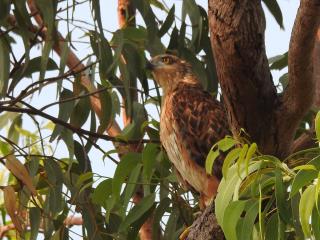
We explore some more areas of southern Kakadu on the way out. The country changes and so do the bird sighting possibilities. We look out for Australian Bustard in flat open plains and stop at potential Gouldian Finch haunts. We explore an area where a pair of Red Goshawks have recently bred and stop at another location where Silver-backed Butcherbirds are reliable.
We have morning tea near the South Alligator River, on Kakadu Highway, continue on to Pine Creek, and then head south to the Fergusson River and Edith Falls. Here there are some reliable areas for Gouldian Finch and Hooded Parrot! Other target species here are Banded Honeyeater, Bar-breasted Honeyeater, Rufous-throated Honeyeater, Budgerigar, Cockatiel, Red-winged Parrot, Varied Lorikeet, Great Bowerbird and Grey-crowned Babbler.
We continue south to Katherine where we will have dinner and spend the night. Accommodation Katherine.
DAY 6 - KATHERINE to PINE CREEK - breakfast with Gouldians
We now head north to a special location alongside a river bed where Gouldians, Hooded Parrots, Northern Rosellas, Cockatiels and many other birds come to drink early in the morning.
We have lunch at Copperfield Dam and continue on to Pine Creek where we check out various areas including the sewerage ponds and cemetery near Pine Creek for Pink-eared Duck, Black-fronted Dotterell, Jacky Winter and various raptors. In Pine Creek itself we usually see Hooded Parrots, Grey-crowned Bablers, Blue-faced Honeyeaters and Red-winged Parrots.
Dinner and accommodation at Pine Creek.
DAY 7 - PINE CREEK to DARWIN
Early breakfast, check out and head north towards Darwin.
We stop for a coffee break at Bridge Creek waterhole and then the small historic township of Adelaide River.
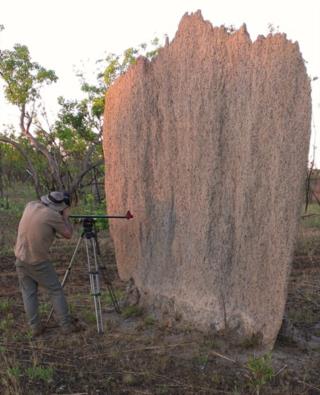
We enter Litchfield National Park and stop to look at some magnificent waterfalls and the wildlife in the area. Here we often find Dingo, Wilkin's Rock Wallaby, Olive Python, Merton’s Water Monitor, Spangled Drongo, Blue-winged Kookaburra, Great Bowerbird, Pheasant Coucal, Pied Butcherbird and Silver-backed Butcherbird. This is also one of the few locations where the amazing magnetic termite mounds are found.
We head back to Darwin now via the back route which takes over the beautiful Finniss River. Both Estuarine and Johnston’s Crocodiles are present here. If there is time we will visit Charles Darwin National Park which is a great site for Northern Rosella and Helmeted Friarbird. Also mangrove birds such as Mangrove Robin, Black Butcherbird, Red-headed Honeyeater, Yellow White-eye, Large-billed Gerygone and Varied Triller.
Return to accommodation in Darwin
Please Note: The above itinerary is based on the outcomes of many previous tours to the areas described. Each season is different and as various wildlife observing opportunities arise and depending on the preferences of the group, adjustments will be made.
Inclusions - Two nights at Mary River Wilderness Retreat (queen bed and single), two nights accommodation at Anbinik Resort, Jabiru (various bedding configurations available), one nights accommodation at Katherine, Pine Creek, Yellow Waters Sunset Cruise, bush breakfasts, picnic lunches and main meals, Kakadu Park entry fees. Cold water, tea and coffee and refreshments available at all times. GST.
Exclusions - Alcoholic drinks, purchases of a personal nature such as souvenirs, internet use, etc.
Group Tour - Maximum five people, $3345 per person twin share, single supplement $525
Private Charter - $9325 (two people)
All prices are in Australian dollars. Please click here for conversion to your currency.
Booking Procedure - You can book directly using our secure online booking site by clicking here. Payment options are Visa, Mastercard, Paypal or Bank Transfer. A 20% deposit secures the booking, the balance is due 30 days prior to start of tour. Please feel free to contact us if you have any queries regarding the tour.
Further Information - Visit our FAQ page to learn more about how our tours run. Visit our 'Darwin Accommodation' links page to find some helpful suggestions for pre and post tour arrangements. Our Terms and Conditions document outlines our cancellation and refund policy. Email enquiries@experiencethewild.com.au or ring Jenny or Mike on 0400 404 058
Bird Photography Ethics
Most nature photographers are cognizant of the needs of birds and avoid causing any undue stress to their avian subjects. We don't use playback to bring birds closer and we keep a respectable distance from nests. There are photos of birds at the nest on this website. These are taken from a reasonable distance with aid of powerful zoom lenses and in most cases, from an established pathway. Also, we don't chase or deliberately flush birds. Quietly stalking them will yield better results, but even this can be interpreted by birds as predatory behaviour. The most satisfying close encounters are had when birds move in to range of their own volition when we wait patiently in the one location. We never place food to bait birds to come in to range either. Guides have the benefit of an intimate familiarity with local species and habitats and can set you up to get great results without resorting to any of these dubious practises. Guests are encouraged to speak up if they see any situation that could be detrimental to birds or habitat while on tour.
Please Click Here to Check Availability and Book Now
